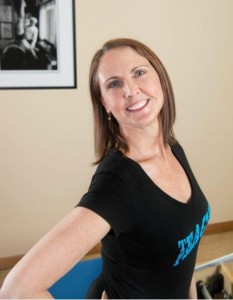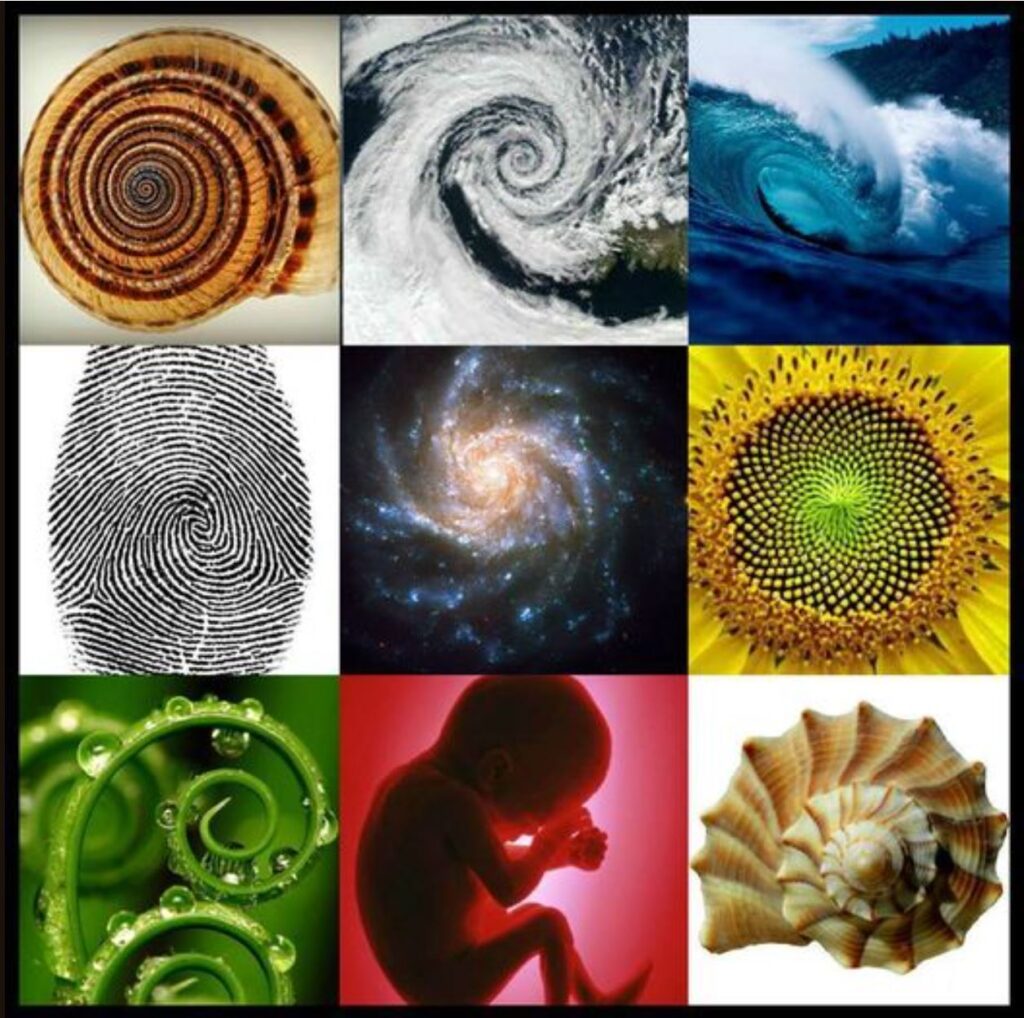Issue #408 – Wednesday, September 3, 2023
“π”-lates: How to Know if a Pilates Movement is Right
Part II
by Amy Alpers
In Part 1. of this article, [link here] we discussed how nature can give you all the answers you need to better understand the Pilates exercises and how to teach them more effectively and healthfully. We looked at several spinal flexion and extension exercises in Pilates, and learned how recognizing the way nature curls and spirals can help you understand how a human spine should do it as well. Now let’s look at spinal twisting exercises and see if nature can answer our questions here too.
Joseph Pilates believed that we should all be able to do several key, natural and normal spinal movements – simply to be healthy. He said #1. When standing, we should all be able to flex our spines forward and touch our palms flat to the floor; #2. We should be able to lie flat on the floor, and starting at the head, roll our spine up one vertebra at a time – just like a wheel – until our head is on our knees; #3. Conversely, we should be able to lie flat, and, starting with our legs, roll over and put our feet on the floor about our heads. And lastly, #4. We should be able to lie flat, roll over and put our feet on the floor above our heads and then draw a circle around ourselves “trying to keep the toes as close to the floor as possible at all times”!!!
Let’s talk about this last one because … wow!
Once I read that, I realized I’d hadn’t been teaching the many Pilates twisting exercises as deeply and powerfully as he intended. Then, when I actually tried this, I understood something way more profound about what he meant. The movement is possibly impossible, but in attempting it, you’ll start to experience something new, and therefore, begin to teach exercises such as Single Leg Circle, Saw, Corkscrew, Hip Circles, Twist on the Reformer, or the Mat, etc. with more insight. And you’ll begin to see how, eventually, these exercises all lead to amazing spinal movement like Control Arabesque, where you roll backwards twisting off and then twist and roll back on to the Reformer. This knew awareness/strength/flexibility will even re-enlighten your basic spinal flexion and extension, exercises as well, such as Short Spine, Tendon Stretch, Snake, Swan, Back Headstands, etc. so they achieve even more powerful health in the spine. As we know, all this leads to the final results of Pilates – better breath, circulation, bodily “house-cleaning”, nervous system tone, and body-mind-spirit revitalization.
Twisting in this manner reveals just how well Mr. Pilates clearly understood the natural, normal movement of the human spine. Snail shells, flower petals, pinecones, snakes, storms, DNA, curly hair, and galaxies all spiral this way. From the microcosm to the macrocosm, left to its own innate wisdom, nature organically spirals. So does the human spine.
Let’s unpack that Corkscrew. Clearly, you need to use caution, both with yourself and your clients, but try going as far and as deeply as you can to get the most benefit and most clarity. To start, it’s the same as usual, you lie flat and roll-over, reaching your feet for the floor – or, ideally, putting them on the floor.
This will increase the flexion of your spine, as well as take the flexion up farther into the thoracic and cervical. It requires a lot more mobility and strength in the chest, back, and shoulders. If you’re a tighter, less flexible person, use your muscle strength to increase your flexion slowly. If you’re a more flexible, less strong person, be sure to use your muscles to strengthen your range (no swinging or rolling – you must lift and bend yourself with muscle strength!).
Once your feet are on (or close to) the floor above your head, keep your entire trunk strong and supported – no hanging in your back or hyperextension anywhere – begin by circling both feet to the right, keeping them on (or very near) the floor – trying to literally “draw” a circle around you as if your toes are a pencil.
Typically people tend to begin this twisting movement at the hips, often by first dropping the back lower. See if you can keep your back lifted up, putting the work forward out of your spine and into your powerfully contracting abdominals. You must always maintain your upper back/arm platform securely so as not to put undue pressure on the neck. However, try to get your abdominals to flex your spine farther over so you are perched as high as possible on your upper back. This will facilitate the twist beginning at the topmost part of the spiral.
No stretching or “falling with style”  . It’s sheer muscle strength – mostly in the abs and upper body. Just like a dishrag, Corkscrew done like this will wring you out completely. Remember that when muscles contract they actually shrink, so allow your trunk to get smaller and more connected muscularly as you move through this. As you get stronger, more flexible, and more in control, you will truly feel the natural, normal spiral the spine is creating. (The pictures show a mat with handles. This makes it easier than having the hands down next to the sides, although hands down at the sides is how Joseph Pilates ultimately meant it to be done.)
. It’s sheer muscle strength – mostly in the abs and upper body. Just like a dishrag, Corkscrew done like this will wring you out completely. Remember that when muscles contract they actually shrink, so allow your trunk to get smaller and more connected muscularly as you move through this. As you get stronger, more flexible, and more in control, you will truly feel the natural, normal spiral the spine is creating. (The pictures show a mat with handles. This makes it easier than having the hands down next to the sides, although hands down at the sides is how Joseph Pilates ultimately meant it to be done.)
Now try your Saw. I think you will feel much more mobility and strength in the abdominals, chest, and upper back/shoulders. You may feel that your movement is bigger and more powerful, and that the twist truly wrings you out.
Try Twist on the Reformer. This very often tends to be similar to the Corkscrew in that the first action of twisting is really a hip drop/rotation. Instead, look over the shoulder you are turning towards and continue to spiral from the top through the chest, ribs, and abdominals, versus the hips. You’ll begin to feel like you’ve spiraled like a tornado, through your whole body. This feeling of twisting to wring yourself out is key to the Pilates Methods intention of deep cleansing – the internal shower.
So how can nature teach us? We learned that mathematics is the actual language of nature. Pi and the Fibonacci Sequence express the truth about how nature – from the universe to the smallest atom or cell – works and moves. Let nature help you to better understand how the spine can flex, extend and twist. Follow its rules and you will bring full body health to your clients.

Amy Taylor Alpers co-founded The Pilates Center (TPC) and The Pilates Center Teacher Training Program (TPCTTP) over 20 years ago in Boulder, Colorado. When not traveling the world to teach both foundational and graduate level Pilates teacher education she remains part of the core faculty for TPCTTP, mentors advanced teachers, teaches classes and sees clients. In addition to teaching TPC sponsored workshops, Amy has presented numerous times at the Pilates Method Alliance Annual Meeting, Balanced Body’s Pilates on Tour and Passing the Torch. In 2013, Amy presented at the Shared Traditions Conference for Fletcher Pilates and will present at The Pilates Roundtable.
Amy was born in Youngstown, Ohio where she began classical ballet at age two.
She attended The Juilliard School for Dance, danced with the Garden State Ballet in New Jersey, and received a B.A. in Dance and a M.A. in Dance History from New York University. In addition, Amy taught ballet at various dance schools in New York City for ten years before launching her Pilates career.
Both Amy and her sister Rachel studied Pilates under the direct tutelage of Romana Kryzanowska at the original Pilates Studio in New York City. They received their Pilates teaching certificate from there in July of 1989. In 1990, after moving to Boulder, Colorado, Amy and Rachel founded The Pilates Center. The sisters then created and established The Pilates Center Teacher Training Program in 1991. The school has since expanded to include an Intermediate Program, Advanced Program, Bridge Program, Master’s Program, and a Mentorship Program. In addition, TPC now has “Licensed” and “Host” studios established all around the world.
Amy and her sister wrote The Everything Pilates Book, published in 2002. She was a founding board member of the PMA and sat on the board that created the PMA Certification Exam. Recently she has also had the honor of filming classes and workshops for online organizations such as Pilates Anytime and Pilates On Demand.
In 2011, Amy, her sister Rachel, and Ken Endelman of Balanced Body, developed CenterLine – a line of equipment designed for classical Pilates and based upon the specifications pioneered by Joseph Pilates.







